Glass is a magical substance formed out of sand and fire that has been molded to serve mankind in innumerable ways. Unique in its transparency, color, and sparkle, its brittleness nevertheless makes it very vulnerable to breakage.
Crystal can be damaged in numerous ways: it can be chipped, cracked, broken, scratched, and stained. Glued Swarovski crystal can come unglued and decanter stoppers can get stuck. Find out if crystal and glass can be repaired.
Waterford & other types of crystal can be repaired by grinding down chips, cleaning stains, polishing scratches, freeing stuck stoppers, & gluing broken stems.
This post summarizes the types of damage commonly befalling glass and links to posts explaining how to fix them.
Artistry in Glass is an Amazon Associate – we earn a commission from qualifying purchases.
Table of contents
- What types of damage affect glass & crystal?
- Dings in paperweights and glass sculptures
- Chips are the commonest form of damage in wine glasses
- Cracks in glass & crystal
- Breaks in glass and crystal
- Broken wineglass stems
- Holes or leaks in cut crystal
- Detached joins in Swarovski crystal
- Stuck or broken stoppers
- Surface damage: stains and scratches
- Conclusion
- Summary of tips for care and cleaning of crystal
What types of damage affect glass & crystal?
A valuable and delicate glass can remain pristine and in perfect shape for hundreds of years until mishandled by a careless custodian. The main categories of damage are those caused by physical impacts, thermal stress (heat), chemical attack (etching) scratching, and staining – summarized in the list below:
- Dings in paperweights & sculptures
- Chips in wine glasses and vases
- Cracks in glassware and flat glass
- Breaks in glassware and flat glass
- Holes or leaks in cut crystal
- Detached joints in Swarovski crystal or footed bowls
- Stuck or broken stoppers in decanters or perfume bottles
- Surface damage – stains & scratches
Take care of your valuable crystal & glassware
Before discussing the various types of damage it’s very important to learn the preventative measures necessary to avoid breakage. Follow this link for full care instructions or jump to this section for a summary:
Dings in paperweights and glass sculptures
Dings are an interesting category of damage where solid, heavy glass like a paperweight or sculpture is impacted by a hard object. Unlike a chip that happens in thin rims, a ding does not detach a chip of glass – rather it forms a crater-like area of damaged/crushed material.
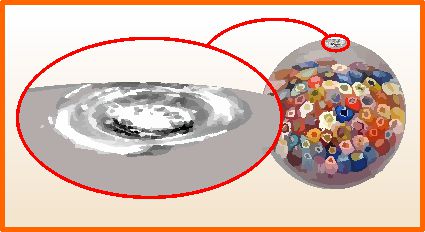
Dings seriously diminish the value of antique paperweights. The damage is generally much deeper than it appears to be and polishing dings down will ruin the proportions of the paperweight. Moderate natural scratches on the base are regarded as normal wear and do not affect the value unduly.
Chips are the commonest form of damage in wine glasses
Can crystal & glass be repaired?
Few articles combine such intrinsic fragility with such a high rate of use and frequency of cleaning than stemmed wine glasses. Great care must be taken in washing (never use a dishwasher) and storage – pay special attention to the delicate rims to avoid chipping.
Chips are small fragments of glass that become detached, generally from the rims of glasses, bowls, or vases when these are impacted by hard objects. The sharper or finer the edge, the more easily it is chipped.
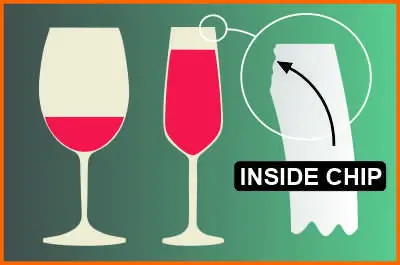
The sharper edges of these glasses are on the inside
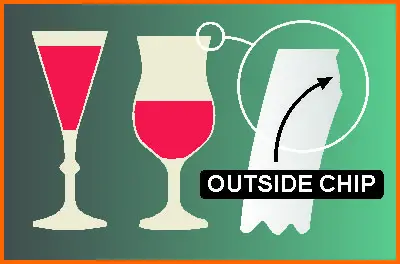
The sharper edges are on the outside
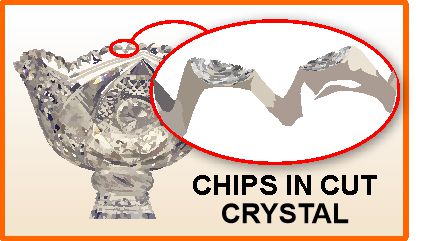
American cut crystal features jagged, “crenulated” edges. These are very vulnerable to chipping by careless handling over the years. They cannot be satisfactorily repaired – only smoothed to remove dangerous sharp edges.
Repairing chips – the bottom line
Chips in wine glasses cannot be removed by melting and they cannot be filled. So the only solution is to grind, smooth, and polish the glass. There are generally two options: one, for the do-it-yourselfer, is to smooth the sharpness of the chip to make the glass safe to use. The second, professional, way is to grind and polish the whole glass down until the chip disappears. Learn all about fixing chips in this comprehensive blog post.
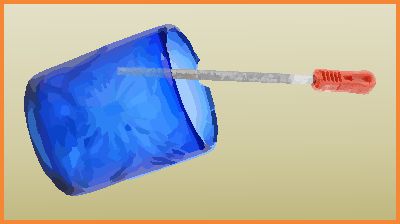
In the do-it-yourself method, note that the chip is not removed – it is just smoothed down to make the glass safe to use.
Note that an irony of the glass repair business is that cheap, thick, soda-lime glass is much harder and therefore harder to polish, than lead crystal.
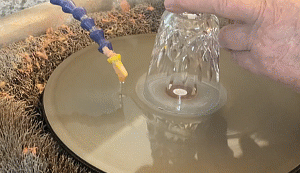
To entirely remove a chip, the whole rim must be ground down until the chip disappears. The repaired glass becomes slightly shorter. In order to grind away the entire rim grinding by hand is too time-consuming so a diamond disk on a rotating lap is necessary. Tucson customers: bring your crystal into Artistry in Glass for expert repair.
Carbide metal file with embedded diamonds
This handy fs both a flat and round side, so you can use it on whatever kind of area you need to smooth. Note that the file will smooth out a chip but leaves a frosted, not polished surface.
Some chips are too large to fix
If the chip is too large – as in the example below – the glass, unfortunately, becomes a write-off.
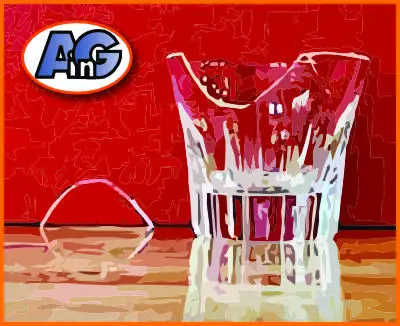
Even with the best UV adhesive, the lines will show when this chip is glued back, Notice that small chips are missing at the impact site and a second large chip (top right) is ready to detach.
The only possible way to rescue this glass is to grind it right down to below the damage – but the resulting glass will be too short to be much use for the serious drinker!
Cracks in glass & crystal
Cracks in crystal glasses, vases, and other vessels are the most difficult category of damage to fix.
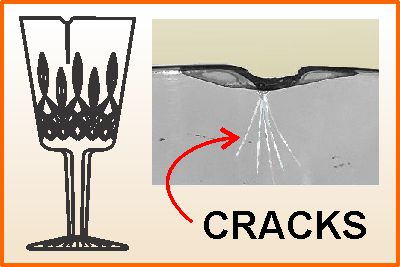
Cracks in glassware and crystal are often found extending down from a chip in the rim. Cracks are generally too tight to allow gluing and can seldom be satisfactorily repaired. Attempting to grind the glass will make the crack “run”. and the only approach is to sandblast the glass down to below the crack creating a much shorter, novelty wine glass.
Types of cracks in float glass
Float glass (window or tabletop glass) also breaks under impact and heat stress but cannot normally be repaired (unless the crack is very small). Like a broken mirror, it is necessary to carefully remove the broken material and insert a new piece.
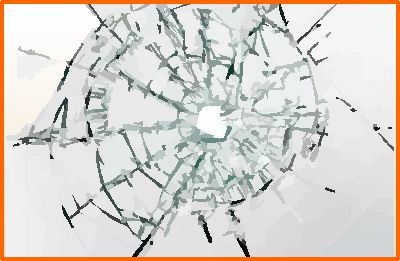
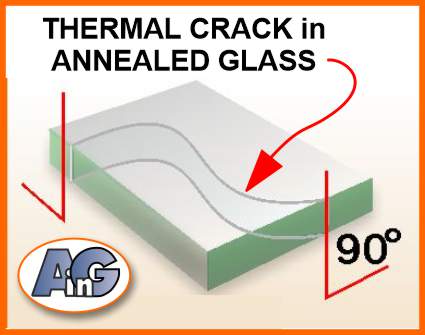
Breaks in glass and crystal
A broken glass container, dish, bowl or vase is easier to fix than a cracked one – because adhesive can be applied to the broken parts.
Objects likely to break are fragile items like stemmed drinking glasses that are used and washed
Other delicate items are vulnerable to damage when moving – crystal chandeliers, curved glass cabinet doors.

Broken glass objects can be glued together
A skilled glass restorer can restore badly broken crystal and glassware by using their skill and experience to use the appropriate adhesive and manual skills. DO NOT TRY THIS AT HOME!!
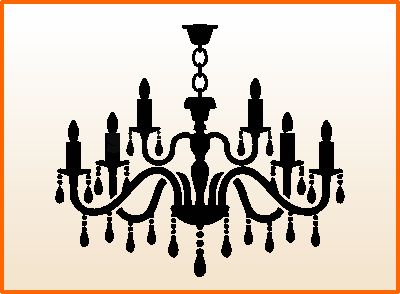
Murano crystal chandeliers are particularly vulnerable to breakage – especially when moving. Crystal pendants are available to replace broken ones but the S-shaped glass arms are very difficult to repair if they are broken.

Chandeliers are available on Amazon for very affordable prices. Use a crystal chandelier to make a luxurious statement over your dining table and learn how to place your dining-room mirror to the best effect.
Broken wineglass stems
Broken stems are notoriously difficult to fix because the gluing area of a thin stem is too small for a strong glue bond. Read this amazing post for all you need to know about fixing broken stems.
Follow this link to learn about the history and the functions of stems on wine glasses.
Holes or leaks in cut crystal
This very unusual type of defect occurs when crystal (for example the Waterford brand) is cut too deeply by the craftsman. This rare mistake occasionally sneaks past the quality control and results in a glass that will “dribble”.
Waterford Lismore Wine Glasses
Very occasionally, the cuts in this classic glass are made too deep by an overzealous glass cutter and the resulting small hole will produce a “dribble” the glass is filled with your favorite wine. There is no satisfactory repair – so return to Amazon!
Detached joins in Swarovski crystal

Glues joints eventually fail and Swarovski crystal figures come apart. These are tricky to position correctly so consult the professionals at Artistry in Glass for expert repair.
We also glue footed bowls and cake stands when the adhesive has failed.
Swarovski Crystal began using chandelier pendants to create simple figures. They of now expanded to a wonderful range of sparking and creative figures featuring animals and other objects. Always keep your figurines in a china cabinet and take great care when handling!
Barski – European crystal . Large centerpiece footed punch bowl – (12″ diameter).
Footed bowls and cake stands like these are made in two parts and the foot is glued to the bowl with a special glass adhesive. Take care when using and especially do not subject to thermal shock – ie do not dump out the ice cubes and immediately fill with hot water!
Stuck or broken stoppers
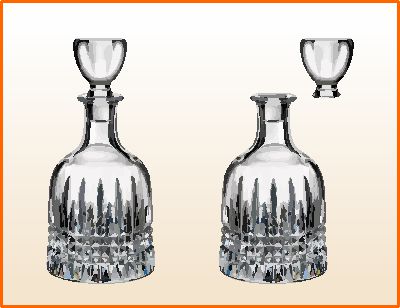
A minor but very irritating problem with crystal containers is that the stoppers often get stuck in decanters and perfume bottles if they are not cleaned regularly.
Great skill and patience is necessary to release stuck stoppers without breaking them. We recommend that you leave this procedure to the professionals.
Always choose lead-free crystal for your decanters – especially if you are pregnant or planning to become pregnant. Read this comprehensive post for all you need to know about the danger of lead in crystal.
Surface damage: stains and scratches
Because glass is transparent, the slightest surface defect shows up very clearly. Crystal and glass can be marred by various surface problems including hard-water deposits, phosphates from dish detergent, and organic stains from evaporated wine or flower water.
Watch this video for foolproof removal of cloudiness
Removing stains & scratches on glass and crystal
There are two methods of repairing surface damage – chemical or mechanical
Chemical means dissolving with a solvent like vinegar and mechanical means polishing with an abrasive.
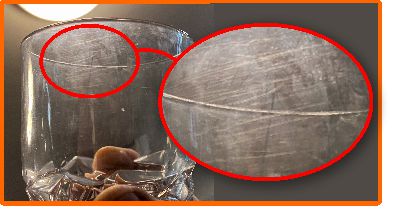
Lead-crystal double-old-fashioned glass with two types of surface defect. Clouding is caused by etching with phosphate chemical attack from dishwasher detergent. Secondary damage is fine scratches caused by abrasive “scotch-pad”.


Water spot remover is our recommendation for removing hard water stains from glassware, shower doors, or windows. Caution! This product is labeled for professional use and must be applied using gloves and a mask.
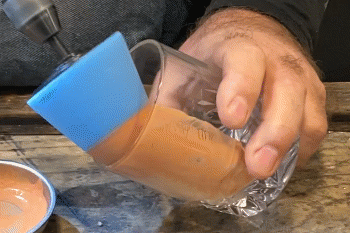
Surface deposits that cannot be dissolved, and also scratches, can be polished away using a paste of cerium oxide on a felt or foam wheel. Cerium can be obtained on Amazon by following this link.
Conclusion
Damaged crystal and glassware can often be repaired but is best left to experts. Tucson customers – consult the professionals at Artistry in Glass.
Summary of tips for care and cleaning of crystal
- Remove rings & jewelry before washing crystal
- Wash glasses in warm soapy water – never in the dishwasher
- Hold crystal by the bowl – never the stem
- Never pour very hot liquid into crystal
- Check for water spots before storing your crystal
- Remove water spots with a mixture of vinegar & water
- Do not store crystal stemware resting on its rim
- Never store one crystal glass inside another one
- Change the water in a crystal flower vase daily
- Wash out a wine decanter after use to avoid staining
Artistry in Glass is your source for antique repair in Tucson
Check out this amazing selection of informative articles:-
- Where can I get antiques repaired?
- Are broken antiques worth fixing?
- How to fix a broken picture frame
- How to repair a broken china plate
- How to repair a broken china teapot
- How to fix a broken marble slab
- How to repair a broken china coffee mug
- How to repair a 2000-year-old sculpture
- All about repairing stained-glass lampshades
- How to care for your stained glass skylight
- How to repair Dalle de Verre
- Is stained glass worth repairing?
- To repair or toss out?
- Tucson crystal & china repair a division of Artistry in Glass
- What to do with broken antiques
- Is lead crystal dangerous?
- Repairing an antique Mexican statue
- Repairing religious statues
- The history of Swarovski crystal figurines
- How to find the value of a Swarovski Crystal figurine
- Have Swarovski crystal figurines lost value since 2009?
- How to collect Swarovski annual ornaments
- How to display Swarovski crystal figurines
- How to authenticate a Swarovski crystal figurine
- How to display Swarovski annual ornaments
- How to clean Swarovski crystal figurines
- How to repair a Swarovski crystal mouse
- How to repair a Swarovski annual ornament
- How to repair a Swarovski crystal train set
- Fixing broken wine glass stems
- How to clean cloudy glasses
- Why do wine glasses have stems?
- Swarovski Crystal Figurines
- How to repair a chip in a wine glass
- How to fix a scratched glass tabletop
- How to replace a broken patio tabletop
Glass tabletops & shelves – info from Artistry in Glass
- Benefits of glass shelving – info from experts!
- How much do glass tabletops cost?
- Do glass shelves need to be tempered?
- What is the best thickness for glass shelves?
- Best edge type for glass shelves, polished or beveled?
- How much weight can a wall shelf carry?
- What color glass should my shelves be?
- Glass tabletops – 10 amazing benefits explained
- How to order a glass tabletop
- Best thickness for glass tabletops – expert advice
- Should glass tabletops be tempered?
- Should glass tabletops be beveled?
- How to paint a glass tabletop
- All about tempering glass tabletops!
- How to tell if your glass is tempered
- Can tempered glass be cut?
- How to protect your wood table with glass
- How to fix a scratched glass tabletop
- How to fix a chipped glass tabletop
- How to replace broken patio table glass
- How to measure for a glass tabletop
- Video – how to measure your tabletop
- Plexiglass vs glass – pros and cons
- Beveled glass table base – a case study
- Choosing between tempered & laminated glass
- Glossary of terms used in the glass business














